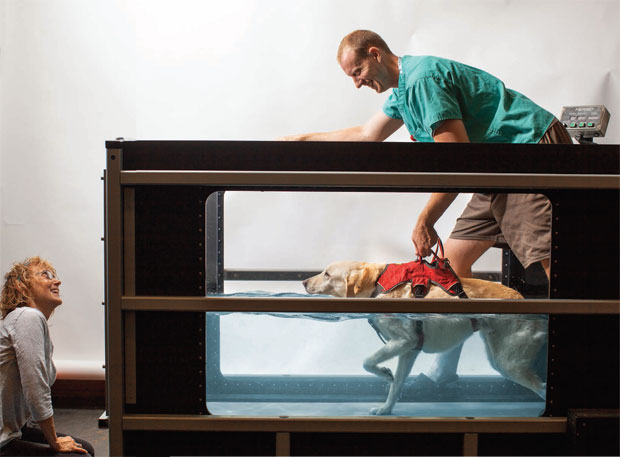
Aqua dog: Chris Frye, DVM ’11, works with canine rehab patient Tella as owner Judy Keil looks on.
Most Friday afternoons, an elderly lady named Tella Keil has physical therapy to help keep her mobile. For thirty minutes she walks slowly on a treadmill inside a water tank, which gives her some much-needed exercise while taking the pressure off her aging joints.
Tella is in her eighties—or she would be, if she were human. In fact, she’s a fifteen-year-old yellow Lab who suffers from arthritis, muscle loss, and other age-related orthopaedic problems. For the past year, owner Judy Keil has been bringing her to the Cornell University Hospital for Animals for rehab treatments overseen by Joseph Wakshlag, DVM ’98, PhD ’05, including the weekly treadmill sessions. “This is great, because it creates buoyancy on a dog that has an end-stage elbow—she can barely move on it—and has bad hips as well,” Wakshlag says, as Tella slowly plods along in water up to her chest. “We put her in here and her motion is more fluid. There’s a lot of pressure taken off, and it allows her to go into a full range of motion.”
In the tank with Tella is veterinary technician Erin Winland. Clad in a T-shirt, shorts, and flip-flops, she straddles the dog and grasps a harness that holds the animal steady. “Mostly what I do is keep her on the treadmill,” says Winland, noting that Tella isn’t particularly enthusiastic about the process. “Each patient’s different; she needs more guidance because she wanders. But she does it because we tell her to, and she’s a good dog. It has kept her moving in her old age.”
‘We like to say that age is not a disease,’ says vet tech Erin Winland. ‘We treat the patient, not their age. Just because Tella is fifteen doesn’t mean she doesn’t have a good quality of life.’Tella was one of the first patients in the hospital’s Sports and Rehabilitation Medicine program, which Wakshlag directs. Founded in spring 2014, it offers a variety of treatments intended to spur healing and maintain mobility, including therapeutic ultrasound, electrical acupuncture, and pain management. Patients range from elderly or injured household pets to canine athletes and working animals such as sled dogs, agility champions, hunting dogs, and police canines. (While the program is primarily geared toward dogs, it treats other species, including cats.) “It’s rewarding to work with the pets and see positive results,” says another of Tella’s doctors, Chris Frye, DVM ’11, who’s doing a Cornell residency in sports and rehabilitation medicine. While Tella is on the treadmill, Frye is monitoring a young German shepherd who’s undergoing a CT scan to diagnose lameness in multiple joints; the animal is under sedation, splayed out on its back with limbs outstretched. “Recently we saw an older St. Bernard who couldn’t walk,” Frye says over the hum of the CT machine in the next room. “We were able to get that patient to lose weight, we injected the joints with pain relief, and we did physical therapy, and the dog is walking for the first time since November. Mom and dad are so happy. We’re giving that animal a second chance.”
On this Friday in May, Tella isn’t just having an aquatic workout. She’s also undergoing laser therapy—which helps manage pain and encourage healing by increasing blood flow to the targeted area—and getting an anabolic steroid shot to build muscle mass. In the past, she has had platelet-rich plasma injected into her joints to stimulate healing; the technique is also used in horses and humans, including (as the Vet college notes on its website) sports stars like Tiger Woods and Kobe Bryant. “We like to say that age is not a disease,” Winland says. “We treat the patient, not their age. Just because Tella is fifteen doesn’t mean she doesn’t have a good quality of life.”
The cost of rehab treatments can add up: the average visit ranges from $60 to $100, Wakshlag says, with patients generally coming in once or twice a week. (If owners can’t afford that frequency, the vets can recommend supplemental exercises to be done at home.) “I feel like I’m doing something positive for Tella,” says Keil, who has five dogs and six cats. “I wouldn’t think of not doing this for her, or any of them.”
While the program’s techniques represent the state of the art in canine rehab—and both Wakshlag and Frye are doing research on the next generation of treatments—its facilities remain a bit primitive. Some metropolitan vet hospitals have dedicated rehab suites, Wakshlag notes, but Cornell’s treadmill tank is located in a breezeway, and consultations are done in a room that’s normally set aside for grieving pet owners. “This kind of treatment is becoming mainstream,” he says, “and to be honest, we’re trying to catch up with the times.”
Eventually, he says, he hopes the program will garner funding for more formal facilities. After all, treating geriatric dogs is a growth industry: just as humans are being kept alive longer thanks to medical advances, so are pets—and many owners are willing to pay for care to keep them happy and healthy. According to a 2011 Harris poll, a whopping 91 percent of pet owners consider their animals to be family members, a three point rise in four years. “The population of dogs is getting older and older,” says Wakshlag. “Often there are things that can keep a dog going and give them quality of life—maybe not forever, but for an extra six or eight months. It helps that dog, and it gives the owner peace of mind that they’ve done everything they can.”


